International and Comparative HRM and ER in Brazilian MNEs
VerifiedAdded on 2022/10/15
|12
|3545
|14
Essay
AI Summary
This essay provides an in-depth analysis of the international and comparative Human Resource Management (HRM) and Employment Relations (ER) practices of Multinational Enterprises (MNEs) operating in Brazil. It explores how MNEs are adapting to globalization and the increasing demand for skilled labor. The essay identifies and analyzes contemporary ER and HRM practices of MNEs in Brazil, assessing their impact on local employees, including an evaluation of how MNEs treat their employees. The essay also highlights the significance of employee motivation, offering strategies to improve employee satisfaction and productivity. It differentiates between the treatment of workers employed by MNE subsidiaries and those employed by local firms that MNEs offshore and outsource to. The essay also examines the spillover effects of MNEs on local firms, including technology transfer and knowledge sharing, concluding with the importance of strategic workforce planning and management within the context of Brazilian HRM practices.
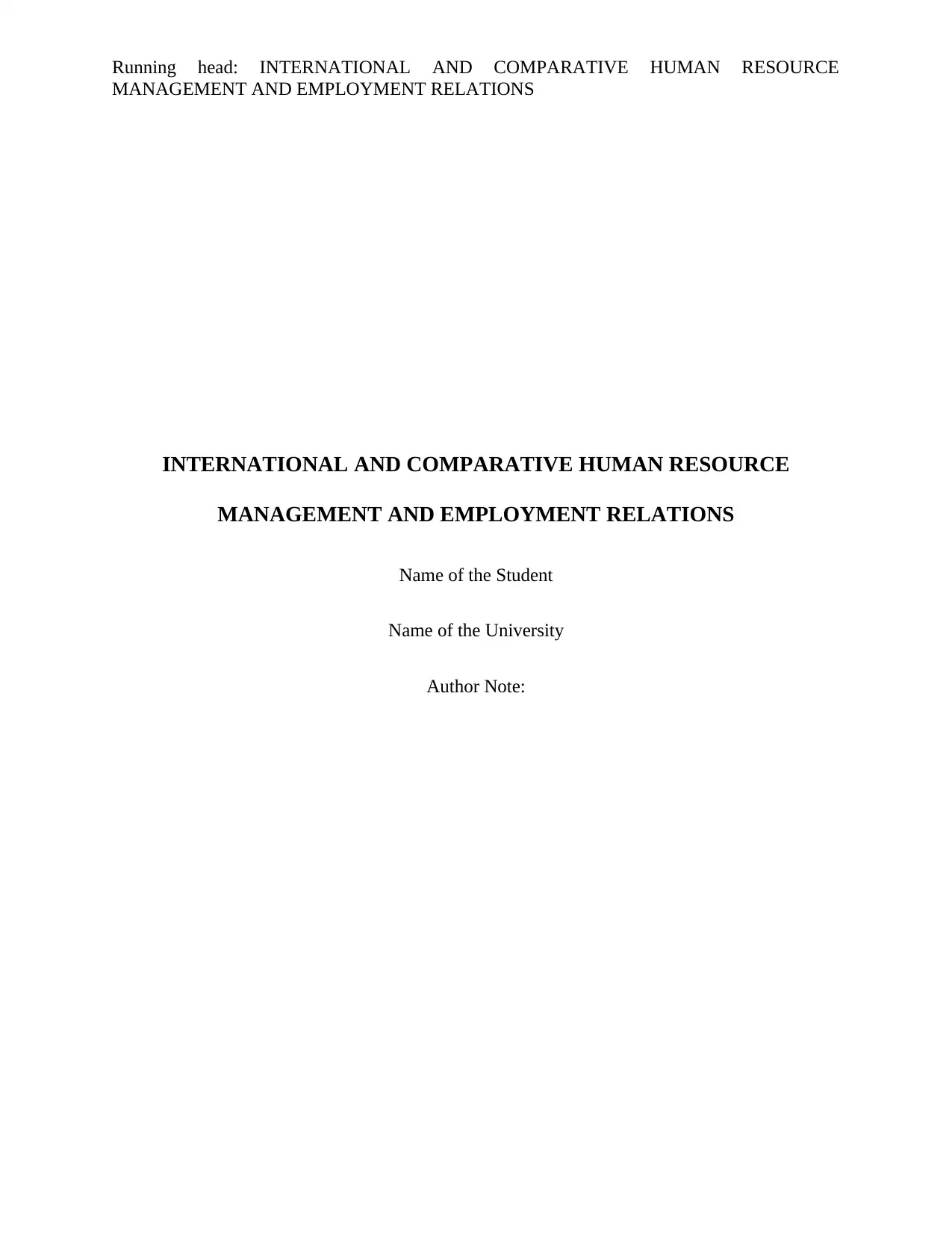
Running head: INTERNATIONAL AND COMPARATIVE HUMAN RESOURCE
MANAGEMENT AND EMPLOYMENT RELATIONS
INTERNATIONAL AND COMPARATIVE HUMAN RESOURCE
MANAGEMENT AND EMPLOYMENT RELATIONS
Name of the Student
Name of the University
Author Note:
MANAGEMENT AND EMPLOYMENT RELATIONS
INTERNATIONAL AND COMPARATIVE HUMAN RESOURCE
MANAGEMENT AND EMPLOYMENT RELATIONS
Name of the Student
Name of the University
Author Note:
Paraphrase This Document
Need a fresh take? Get an instant paraphrase of this document with our AI Paraphraser
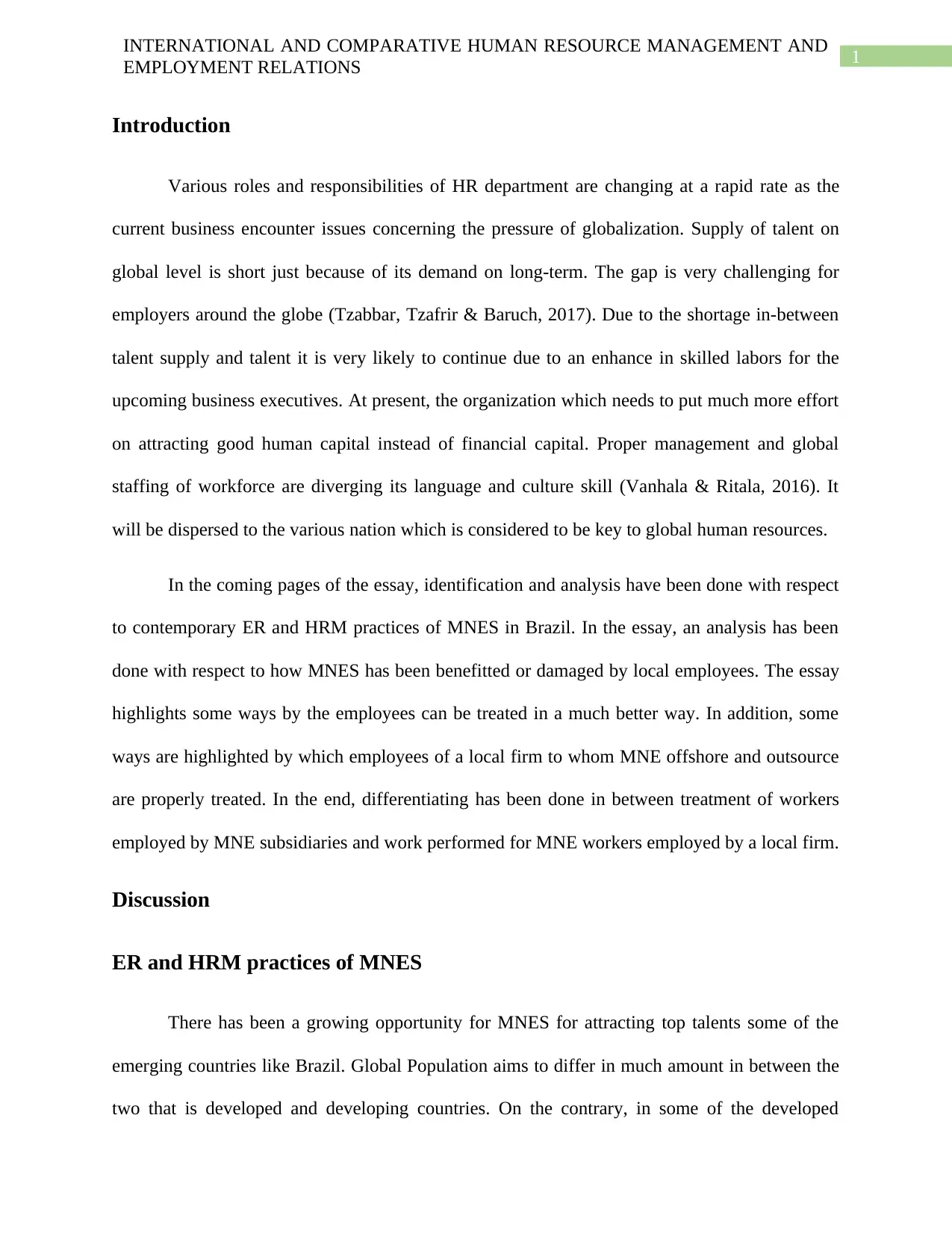
1
INTERNATIONAL AND COMPARATIVE HUMAN RESOURCE MANAGEMENT AND
EMPLOYMENT RELATIONS
Introduction
Various roles and responsibilities of HR department are changing at a rapid rate as the
current business encounter issues concerning the pressure of globalization. Supply of talent on
global level is short just because of its demand on long-term. The gap is very challenging for
employers around the globe (Tzabbar, Tzafrir & Baruch, 2017). Due to the shortage in-between
talent supply and talent it is very likely to continue due to an enhance in skilled labors for the
upcoming business executives. At present, the organization which needs to put much more effort
on attracting good human capital instead of financial capital. Proper management and global
staffing of workforce are diverging its language and culture skill (Vanhala & Ritala, 2016). It
will be dispersed to the various nation which is considered to be key to global human resources.
In the coming pages of the essay, identification and analysis have been done with respect
to contemporary ER and HRM practices of MNES in Brazil. In the essay, an analysis has been
done with respect to how MNES has been benefitted or damaged by local employees. The essay
highlights some ways by the employees can be treated in a much better way. In addition, some
ways are highlighted by which employees of a local firm to whom MNE offshore and outsource
are properly treated. In the end, differentiating has been done in between treatment of workers
employed by MNE subsidiaries and work performed for MNE workers employed by a local firm.
Discussion
ER and HRM practices of MNES
There has been a growing opportunity for MNES for attracting top talents some of the
emerging countries like Brazil. Global Population aims to differ in much amount in between the
two that is developed and developing countries. On the contrary, in some of the developed
INTERNATIONAL AND COMPARATIVE HUMAN RESOURCE MANAGEMENT AND
EMPLOYMENT RELATIONS
Introduction
Various roles and responsibilities of HR department are changing at a rapid rate as the
current business encounter issues concerning the pressure of globalization. Supply of talent on
global level is short just because of its demand on long-term. The gap is very challenging for
employers around the globe (Tzabbar, Tzafrir & Baruch, 2017). Due to the shortage in-between
talent supply and talent it is very likely to continue due to an enhance in skilled labors for the
upcoming business executives. At present, the organization which needs to put much more effort
on attracting good human capital instead of financial capital. Proper management and global
staffing of workforce are diverging its language and culture skill (Vanhala & Ritala, 2016). It
will be dispersed to the various nation which is considered to be key to global human resources.
In the coming pages of the essay, identification and analysis have been done with respect
to contemporary ER and HRM practices of MNES in Brazil. In the essay, an analysis has been
done with respect to how MNES has been benefitted or damaged by local employees. The essay
highlights some ways by the employees can be treated in a much better way. In addition, some
ways are highlighted by which employees of a local firm to whom MNE offshore and outsource
are properly treated. In the end, differentiating has been done in between treatment of workers
employed by MNE subsidiaries and work performed for MNE workers employed by a local firm.
Discussion
ER and HRM practices of MNES
There has been a growing opportunity for MNES for attracting top talents some of the
emerging countries like Brazil. Global Population aims to differ in much amount in between the
two that is developed and developing countries. On the contrary, in some of the developed
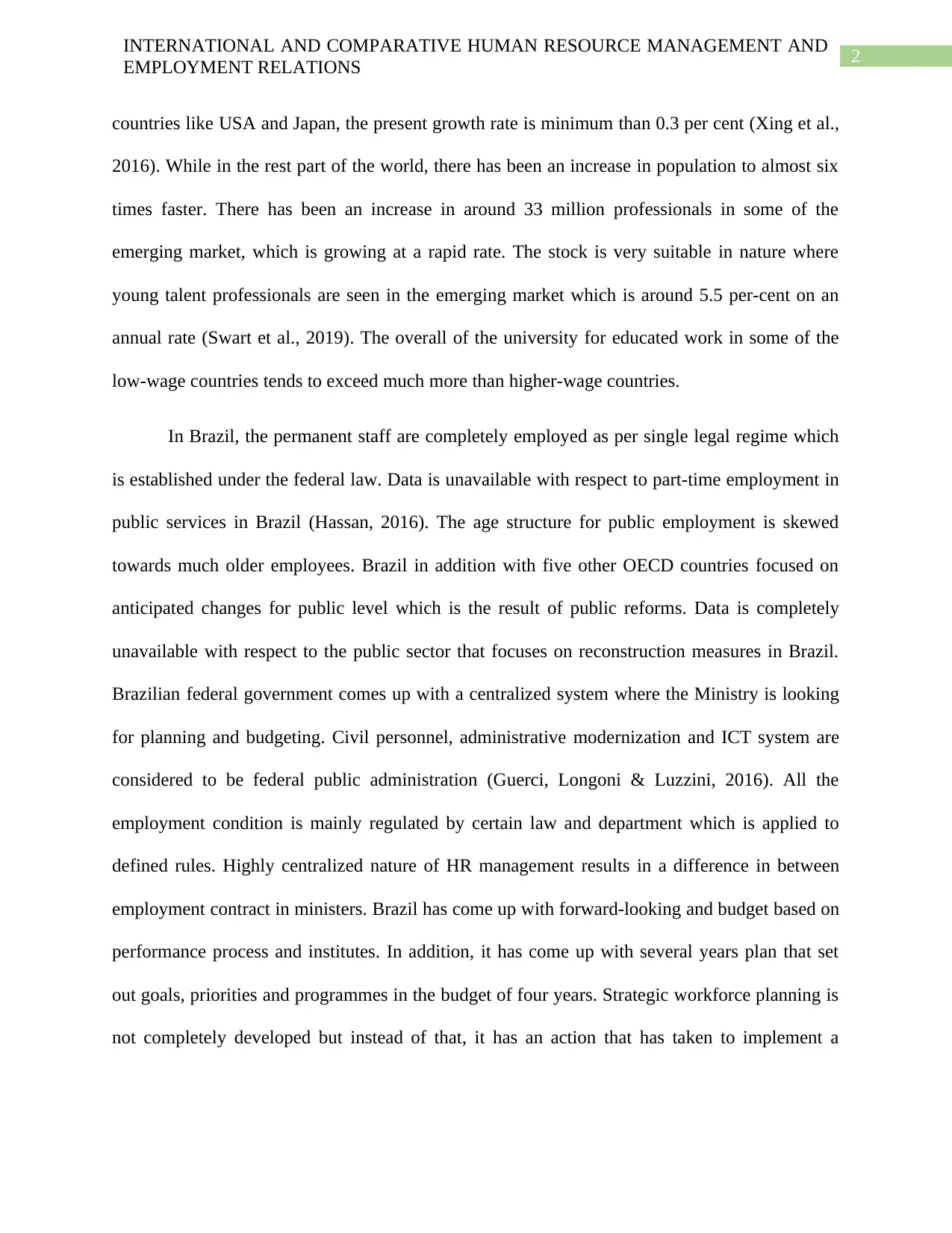
2
INTERNATIONAL AND COMPARATIVE HUMAN RESOURCE MANAGEMENT AND
EMPLOYMENT RELATIONS
countries like USA and Japan, the present growth rate is minimum than 0.3 per cent (Xing et al.,
2016). While in the rest part of the world, there has been an increase in population to almost six
times faster. There has been an increase in around 33 million professionals in some of the
emerging market, which is growing at a rapid rate. The stock is very suitable in nature where
young talent professionals are seen in the emerging market which is around 5.5 per-cent on an
annual rate (Swart et al., 2019). The overall of the university for educated work in some of the
low-wage countries tends to exceed much more than higher-wage countries.
In Brazil, the permanent staff are completely employed as per single legal regime which
is established under the federal law. Data is unavailable with respect to part-time employment in
public services in Brazil (Hassan, 2016). The age structure for public employment is skewed
towards much older employees. Brazil in addition with five other OECD countries focused on
anticipated changes for public level which is the result of public reforms. Data is completely
unavailable with respect to the public sector that focuses on reconstruction measures in Brazil.
Brazilian federal government comes up with a centralized system where the Ministry is looking
for planning and budgeting. Civil personnel, administrative modernization and ICT system are
considered to be federal public administration (Guerci, Longoni & Luzzini, 2016). All the
employment condition is mainly regulated by certain law and department which is applied to
defined rules. Highly centralized nature of HR management results in a difference in between
employment contract in ministers. Brazil has come up with forward-looking and budget based on
performance process and institutes. In addition, it has come up with several years plan that set
out goals, priorities and programmes in the budget of four years. Strategic workforce planning is
not completely developed but instead of that, it has an action that has taken to implement a
INTERNATIONAL AND COMPARATIVE HUMAN RESOURCE MANAGEMENT AND
EMPLOYMENT RELATIONS
countries like USA and Japan, the present growth rate is minimum than 0.3 per cent (Xing et al.,
2016). While in the rest part of the world, there has been an increase in population to almost six
times faster. There has been an increase in around 33 million professionals in some of the
emerging market, which is growing at a rapid rate. The stock is very suitable in nature where
young talent professionals are seen in the emerging market which is around 5.5 per-cent on an
annual rate (Swart et al., 2019). The overall of the university for educated work in some of the
low-wage countries tends to exceed much more than higher-wage countries.
In Brazil, the permanent staff are completely employed as per single legal regime which
is established under the federal law. Data is unavailable with respect to part-time employment in
public services in Brazil (Hassan, 2016). The age structure for public employment is skewed
towards much older employees. Brazil in addition with five other OECD countries focused on
anticipated changes for public level which is the result of public reforms. Data is completely
unavailable with respect to the public sector that focuses on reconstruction measures in Brazil.
Brazilian federal government comes up with a centralized system where the Ministry is looking
for planning and budgeting. Civil personnel, administrative modernization and ICT system are
considered to be federal public administration (Guerci, Longoni & Luzzini, 2016). All the
employment condition is mainly regulated by certain law and department which is applied to
defined rules. Highly centralized nature of HR management results in a difference in between
employment contract in ministers. Brazil has come up with forward-looking and budget based on
performance process and institutes. In addition, it has come up with several years plan that set
out goals, priorities and programmes in the budget of four years. Strategic workforce planning is
not completely developed but instead of that, it has an action that has taken to implement a
⊘ This is a preview!⊘
Do you want full access?
Subscribe today to unlock all pages.

Trusted by 1+ million students worldwide
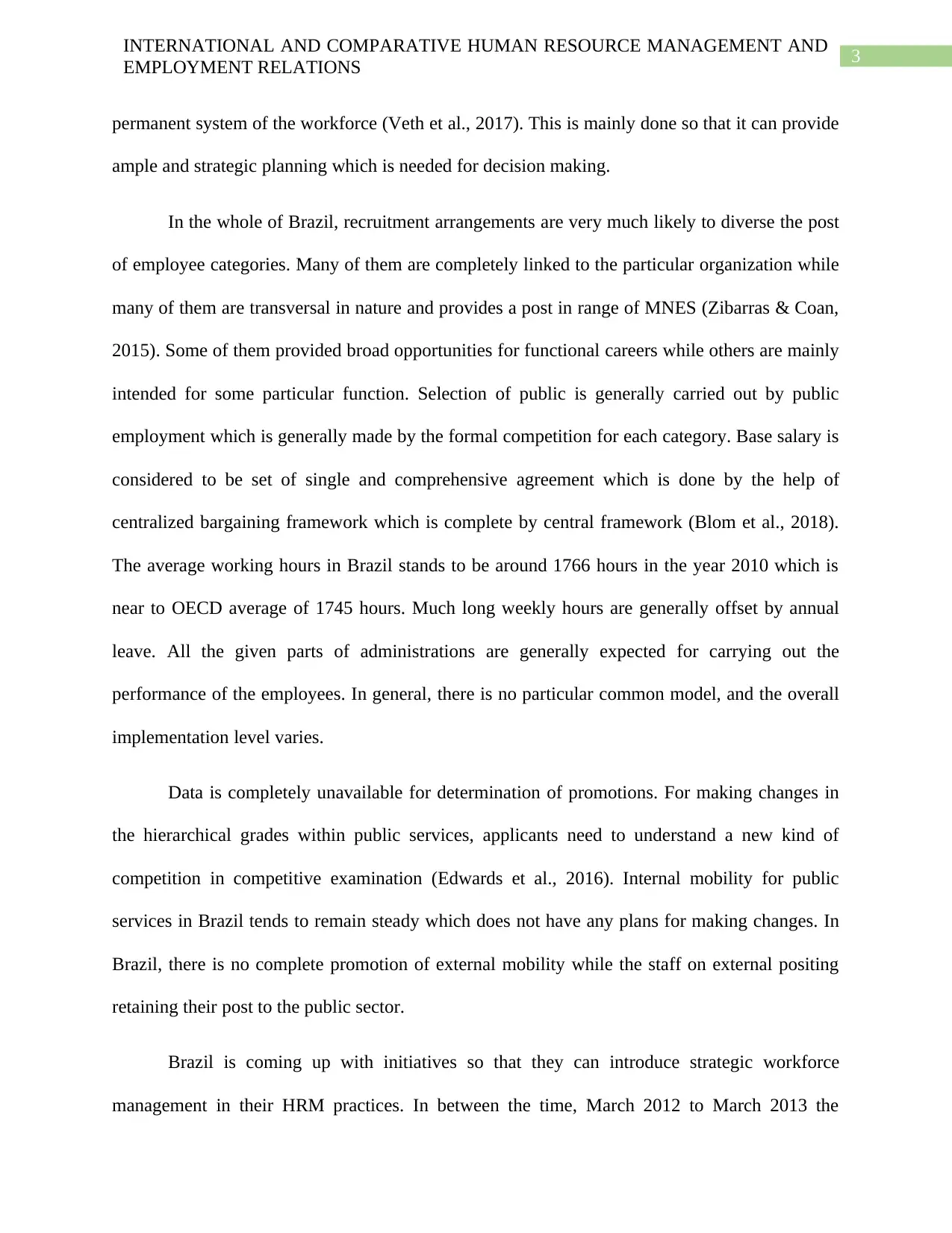
3
INTERNATIONAL AND COMPARATIVE HUMAN RESOURCE MANAGEMENT AND
EMPLOYMENT RELATIONS
permanent system of the workforce (Veth et al., 2017). This is mainly done so that it can provide
ample and strategic planning which is needed for decision making.
In the whole of Brazil, recruitment arrangements are very much likely to diverse the post
of employee categories. Many of them are completely linked to the particular organization while
many of them are transversal in nature and provides a post in range of MNES (Zibarras & Coan,
2015). Some of them provided broad opportunities for functional careers while others are mainly
intended for some particular function. Selection of public is generally carried out by public
employment which is generally made by the formal competition for each category. Base salary is
considered to be set of single and comprehensive agreement which is done by the help of
centralized bargaining framework which is complete by central framework (Blom et al., 2018).
The average working hours in Brazil stands to be around 1766 hours in the year 2010 which is
near to OECD average of 1745 hours. Much long weekly hours are generally offset by annual
leave. All the given parts of administrations are generally expected for carrying out the
performance of the employees. In general, there is no particular common model, and the overall
implementation level varies.
Data is completely unavailable for determination of promotions. For making changes in
the hierarchical grades within public services, applicants need to understand a new kind of
competition in competitive examination (Edwards et al., 2016). Internal mobility for public
services in Brazil tends to remain steady which does not have any plans for making changes. In
Brazil, there is no complete promotion of external mobility while the staff on external positing
retaining their post to the public sector.
Brazil is coming up with initiatives so that they can introduce strategic workforce
management in their HRM practices. In between the time, March 2012 to March 2013 the
INTERNATIONAL AND COMPARATIVE HUMAN RESOURCE MANAGEMENT AND
EMPLOYMENT RELATIONS
permanent system of the workforce (Veth et al., 2017). This is mainly done so that it can provide
ample and strategic planning which is needed for decision making.
In the whole of Brazil, recruitment arrangements are very much likely to diverse the post
of employee categories. Many of them are completely linked to the particular organization while
many of them are transversal in nature and provides a post in range of MNES (Zibarras & Coan,
2015). Some of them provided broad opportunities for functional careers while others are mainly
intended for some particular function. Selection of public is generally carried out by public
employment which is generally made by the formal competition for each category. Base salary is
considered to be set of single and comprehensive agreement which is done by the help of
centralized bargaining framework which is complete by central framework (Blom et al., 2018).
The average working hours in Brazil stands to be around 1766 hours in the year 2010 which is
near to OECD average of 1745 hours. Much long weekly hours are generally offset by annual
leave. All the given parts of administrations are generally expected for carrying out the
performance of the employees. In general, there is no particular common model, and the overall
implementation level varies.
Data is completely unavailable for determination of promotions. For making changes in
the hierarchical grades within public services, applicants need to understand a new kind of
competition in competitive examination (Edwards et al., 2016). Internal mobility for public
services in Brazil tends to remain steady which does not have any plans for making changes. In
Brazil, there is no complete promotion of external mobility while the staff on external positing
retaining their post to the public sector.
Brazil is coming up with initiatives so that they can introduce strategic workforce
management in their HRM practices. In between the time, March 2012 to March 2013 the
Paraphrase This Document
Need a fresh take? Get an instant paraphrase of this document with our AI Paraphraser
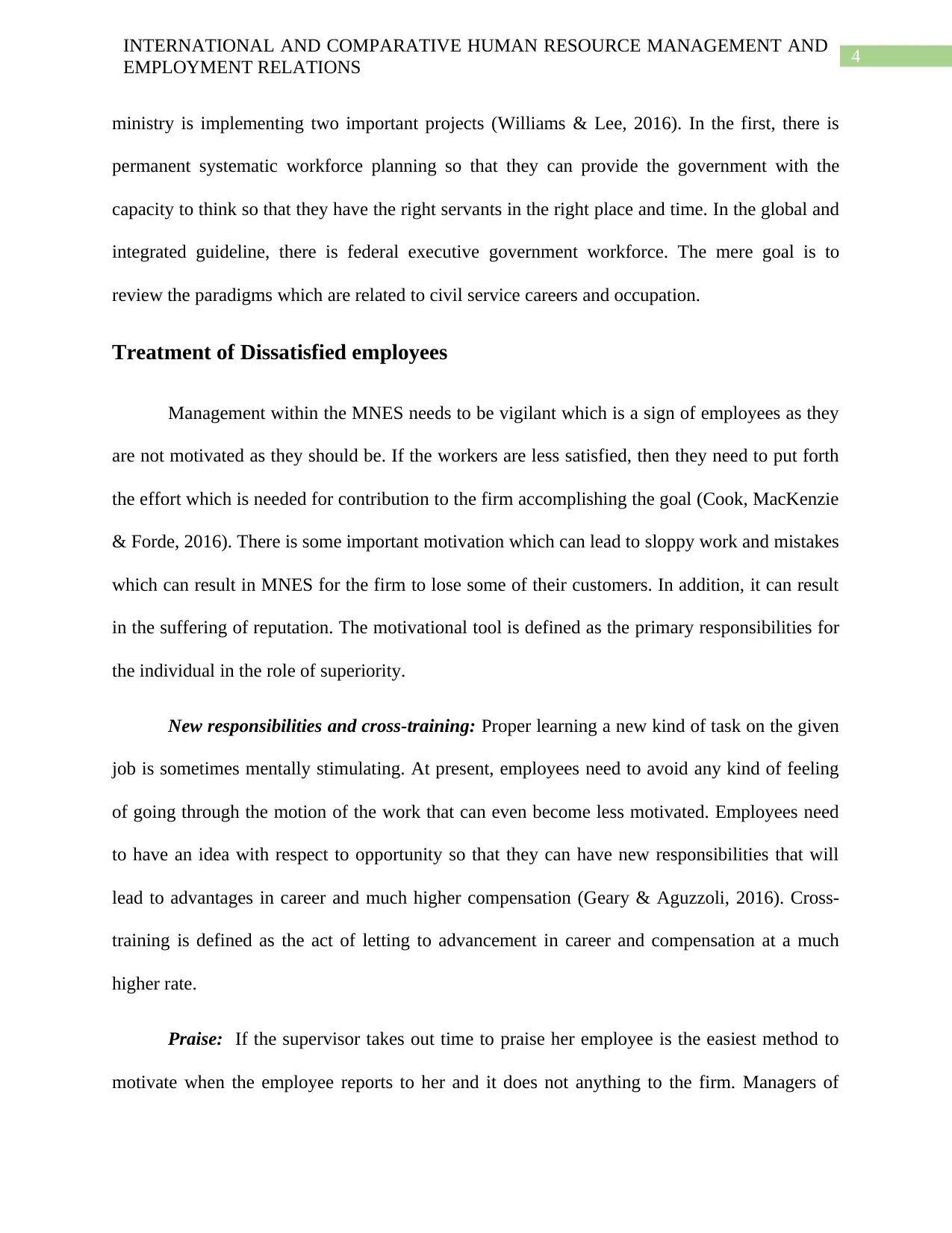
4
INTERNATIONAL AND COMPARATIVE HUMAN RESOURCE MANAGEMENT AND
EMPLOYMENT RELATIONS
ministry is implementing two important projects (Williams & Lee, 2016). In the first, there is
permanent systematic workforce planning so that they can provide the government with the
capacity to think so that they have the right servants in the right place and time. In the global and
integrated guideline, there is federal executive government workforce. The mere goal is to
review the paradigms which are related to civil service careers and occupation.
Treatment of Dissatisfied employees
Management within the MNES needs to be vigilant which is a sign of employees as they
are not motivated as they should be. If the workers are less satisfied, then they need to put forth
the effort which is needed for contribution to the firm accomplishing the goal (Cook, MacKenzie
& Forde, 2016). There is some important motivation which can lead to sloppy work and mistakes
which can result in MNES for the firm to lose some of their customers. In addition, it can result
in the suffering of reputation. The motivational tool is defined as the primary responsibilities for
the individual in the role of superiority.
New responsibilities and cross-training: Proper learning a new kind of task on the given
job is sometimes mentally stimulating. At present, employees need to avoid any kind of feeling
of going through the motion of the work that can even become less motivated. Employees need
to have an idea with respect to opportunity so that they can have new responsibilities that will
lead to advantages in career and much higher compensation (Geary & Aguzzoli, 2016). Cross-
training is defined as the act of letting to advancement in career and compensation at a much
higher rate.
Praise: If the supervisor takes out time to praise her employee is the easiest method to
motivate when the employee reports to her and it does not anything to the firm. Managers of
INTERNATIONAL AND COMPARATIVE HUMAN RESOURCE MANAGEMENT AND
EMPLOYMENT RELATIONS
ministry is implementing two important projects (Williams & Lee, 2016). In the first, there is
permanent systematic workforce planning so that they can provide the government with the
capacity to think so that they have the right servants in the right place and time. In the global and
integrated guideline, there is federal executive government workforce. The mere goal is to
review the paradigms which are related to civil service careers and occupation.
Treatment of Dissatisfied employees
Management within the MNES needs to be vigilant which is a sign of employees as they
are not motivated as they should be. If the workers are less satisfied, then they need to put forth
the effort which is needed for contribution to the firm accomplishing the goal (Cook, MacKenzie
& Forde, 2016). There is some important motivation which can lead to sloppy work and mistakes
which can result in MNES for the firm to lose some of their customers. In addition, it can result
in the suffering of reputation. The motivational tool is defined as the primary responsibilities for
the individual in the role of superiority.
New responsibilities and cross-training: Proper learning a new kind of task on the given
job is sometimes mentally stimulating. At present, employees need to avoid any kind of feeling
of going through the motion of the work that can even become less motivated. Employees need
to have an idea with respect to opportunity so that they can have new responsibilities that will
lead to advantages in career and much higher compensation (Geary & Aguzzoli, 2016). Cross-
training is defined as the act of letting to advancement in career and compensation at a much
higher rate.
Praise: If the supervisor takes out time to praise her employee is the easiest method to
motivate when the employee reports to her and it does not anything to the firm. Managers of
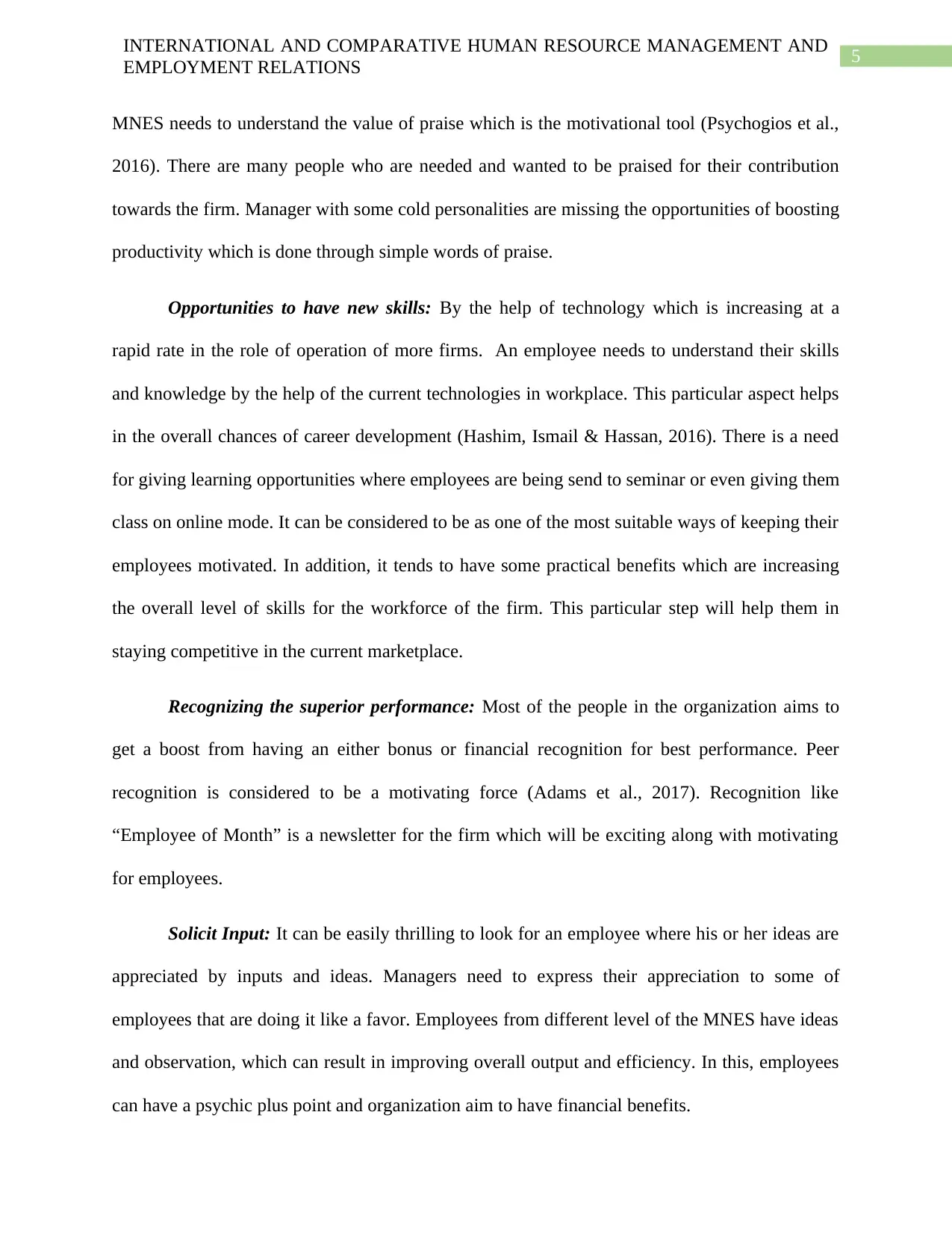
5
INTERNATIONAL AND COMPARATIVE HUMAN RESOURCE MANAGEMENT AND
EMPLOYMENT RELATIONS
MNES needs to understand the value of praise which is the motivational tool (Psychogios et al.,
2016). There are many people who are needed and wanted to be praised for their contribution
towards the firm. Manager with some cold personalities are missing the opportunities of boosting
productivity which is done through simple words of praise.
Opportunities to have new skills: By the help of technology which is increasing at a
rapid rate in the role of operation of more firms. An employee needs to understand their skills
and knowledge by the help of the current technologies in workplace. This particular aspect helps
in the overall chances of career development (Hashim, Ismail & Hassan, 2016). There is a need
for giving learning opportunities where employees are being send to seminar or even giving them
class on online mode. It can be considered to be as one of the most suitable ways of keeping their
employees motivated. In addition, it tends to have some practical benefits which are increasing
the overall level of skills for the workforce of the firm. This particular step will help them in
staying competitive in the current marketplace.
Recognizing the superior performance: Most of the people in the organization aims to
get a boost from having an either bonus or financial recognition for best performance. Peer
recognition is considered to be a motivating force (Adams et al., 2017). Recognition like
“Employee of Month” is a newsletter for the firm which will be exciting along with motivating
for employees.
Solicit Input: It can be easily thrilling to look for an employee where his or her ideas are
appreciated by inputs and ideas. Managers need to express their appreciation to some of
employees that are doing it like a favor. Employees from different level of the MNES have ideas
and observation, which can result in improving overall output and efficiency. In this, employees
can have a psychic plus point and organization aim to have financial benefits.
INTERNATIONAL AND COMPARATIVE HUMAN RESOURCE MANAGEMENT AND
EMPLOYMENT RELATIONS
MNES needs to understand the value of praise which is the motivational tool (Psychogios et al.,
2016). There are many people who are needed and wanted to be praised for their contribution
towards the firm. Manager with some cold personalities are missing the opportunities of boosting
productivity which is done through simple words of praise.
Opportunities to have new skills: By the help of technology which is increasing at a
rapid rate in the role of operation of more firms. An employee needs to understand their skills
and knowledge by the help of the current technologies in workplace. This particular aspect helps
in the overall chances of career development (Hashim, Ismail & Hassan, 2016). There is a need
for giving learning opportunities where employees are being send to seminar or even giving them
class on online mode. It can be considered to be as one of the most suitable ways of keeping their
employees motivated. In addition, it tends to have some practical benefits which are increasing
the overall level of skills for the workforce of the firm. This particular step will help them in
staying competitive in the current marketplace.
Recognizing the superior performance: Most of the people in the organization aims to
get a boost from having an either bonus or financial recognition for best performance. Peer
recognition is considered to be a motivating force (Adams et al., 2017). Recognition like
“Employee of Month” is a newsletter for the firm which will be exciting along with motivating
for employees.
Solicit Input: It can be easily thrilling to look for an employee where his or her ideas are
appreciated by inputs and ideas. Managers need to express their appreciation to some of
employees that are doing it like a favor. Employees from different level of the MNES have ideas
and observation, which can result in improving overall output and efficiency. In this, employees
can have a psychic plus point and organization aim to have financial benefits.
⊘ This is a preview!⊘
Do you want full access?
Subscribe today to unlock all pages.

Trusted by 1+ million students worldwide
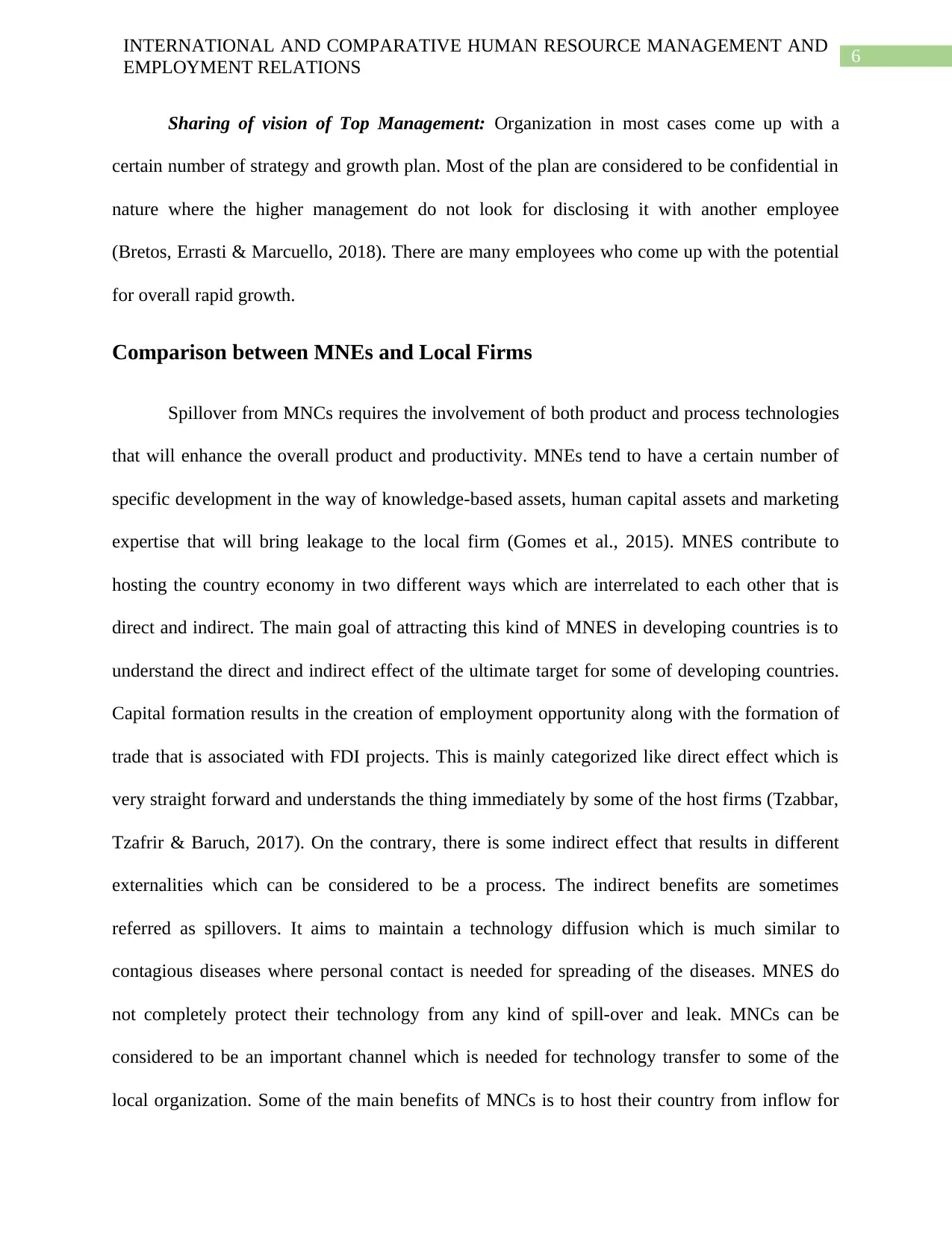
6
INTERNATIONAL AND COMPARATIVE HUMAN RESOURCE MANAGEMENT AND
EMPLOYMENT RELATIONS
Sharing of vision of Top Management: Organization in most cases come up with a
certain number of strategy and growth plan. Most of the plan are considered to be confidential in
nature where the higher management do not look for disclosing it with another employee
(Bretos, Errasti & Marcuello, 2018). There are many employees who come up with the potential
for overall rapid growth.
Comparison between MNEs and Local Firms
Spillover from MNCs requires the involvement of both product and process technologies
that will enhance the overall product and productivity. MNEs tend to have a certain number of
specific development in the way of knowledge-based assets, human capital assets and marketing
expertise that will bring leakage to the local firm (Gomes et al., 2015). MNES contribute to
hosting the country economy in two different ways which are interrelated to each other that is
direct and indirect. The main goal of attracting this kind of MNES in developing countries is to
understand the direct and indirect effect of the ultimate target for some of developing countries.
Capital formation results in the creation of employment opportunity along with the formation of
trade that is associated with FDI projects. This is mainly categorized like direct effect which is
very straight forward and understands the thing immediately by some of the host firms (Tzabbar,
Tzafrir & Baruch, 2017). On the contrary, there is some indirect effect that results in different
externalities which can be considered to be a process. The indirect benefits are sometimes
referred as spillovers. It aims to maintain a technology diffusion which is much similar to
contagious diseases where personal contact is needed for spreading of the diseases. MNES do
not completely protect their technology from any kind of spill-over and leak. MNCs can be
considered to be an important channel which is needed for technology transfer to some of the
local organization. Some of the main benefits of MNCs is to host their country from inflow for
INTERNATIONAL AND COMPARATIVE HUMAN RESOURCE MANAGEMENT AND
EMPLOYMENT RELATIONS
Sharing of vision of Top Management: Organization in most cases come up with a
certain number of strategy and growth plan. Most of the plan are considered to be confidential in
nature where the higher management do not look for disclosing it with another employee
(Bretos, Errasti & Marcuello, 2018). There are many employees who come up with the potential
for overall rapid growth.
Comparison between MNEs and Local Firms
Spillover from MNCs requires the involvement of both product and process technologies
that will enhance the overall product and productivity. MNEs tend to have a certain number of
specific development in the way of knowledge-based assets, human capital assets and marketing
expertise that will bring leakage to the local firm (Gomes et al., 2015). MNES contribute to
hosting the country economy in two different ways which are interrelated to each other that is
direct and indirect. The main goal of attracting this kind of MNES in developing countries is to
understand the direct and indirect effect of the ultimate target for some of developing countries.
Capital formation results in the creation of employment opportunity along with the formation of
trade that is associated with FDI projects. This is mainly categorized like direct effect which is
very straight forward and understands the thing immediately by some of the host firms (Tzabbar,
Tzafrir & Baruch, 2017). On the contrary, there is some indirect effect that results in different
externalities which can be considered to be a process. The indirect benefits are sometimes
referred as spillovers. It aims to maintain a technology diffusion which is much similar to
contagious diseases where personal contact is needed for spreading of the diseases. MNES do
not completely protect their technology from any kind of spill-over and leak. MNCs can be
considered to be an important channel which is needed for technology transfer to some of the
local organization. Some of the main benefits of MNCs is to host their country from inflow for
Paraphrase This Document
Need a fresh take? Get an instant paraphrase of this document with our AI Paraphraser
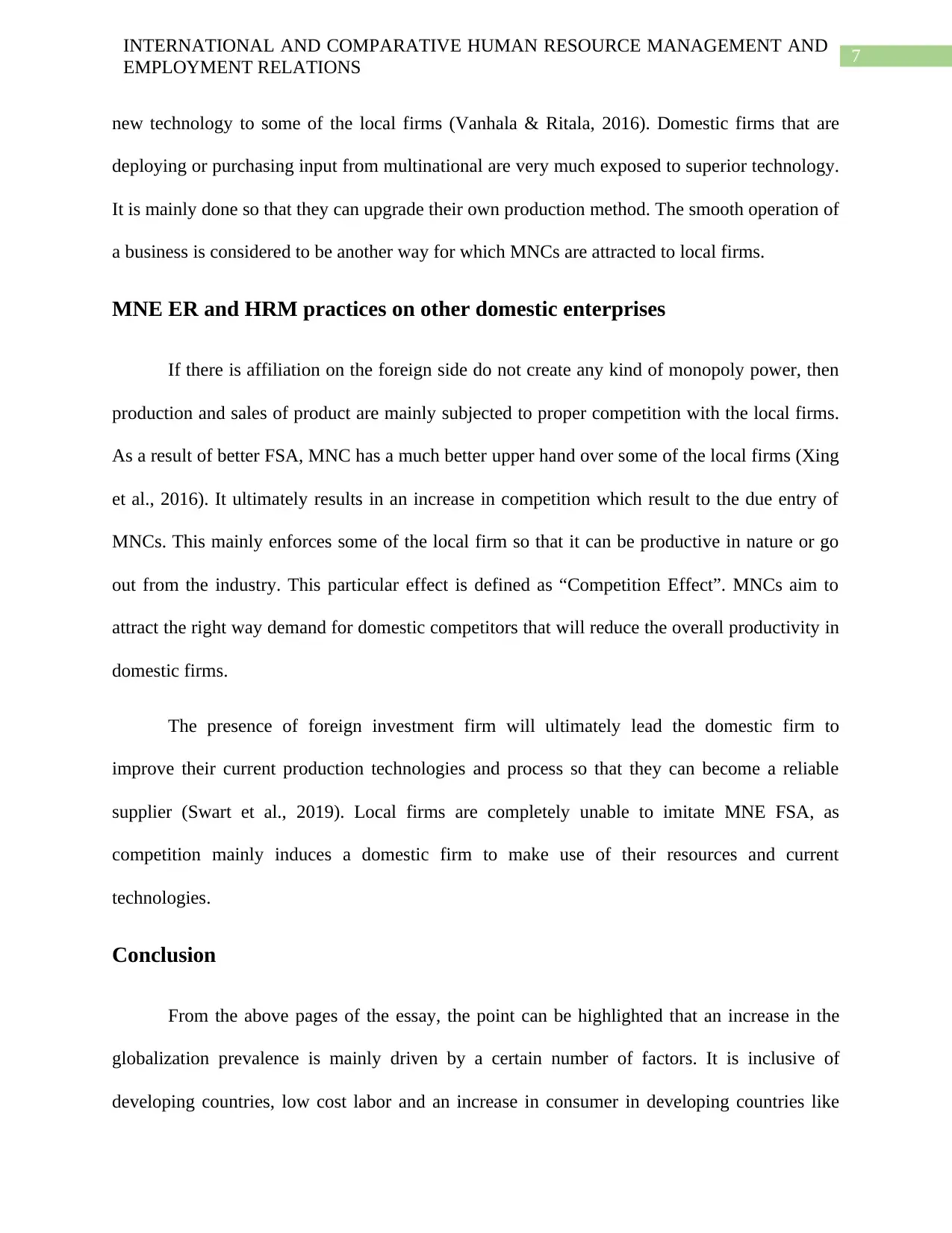
7
INTERNATIONAL AND COMPARATIVE HUMAN RESOURCE MANAGEMENT AND
EMPLOYMENT RELATIONS
new technology to some of the local firms (Vanhala & Ritala, 2016). Domestic firms that are
deploying or purchasing input from multinational are very much exposed to superior technology.
It is mainly done so that they can upgrade their own production method. The smooth operation of
a business is considered to be another way for which MNCs are attracted to local firms.
MNE ER and HRM practices on other domestic enterprises
If there is affiliation on the foreign side do not create any kind of monopoly power, then
production and sales of product are mainly subjected to proper competition with the local firms.
As a result of better FSA, MNC has a much better upper hand over some of the local firms (Xing
et al., 2016). It ultimately results in an increase in competition which result to the due entry of
MNCs. This mainly enforces some of the local firm so that it can be productive in nature or go
out from the industry. This particular effect is defined as “Competition Effect”. MNCs aim to
attract the right way demand for domestic competitors that will reduce the overall productivity in
domestic firms.
The presence of foreign investment firm will ultimately lead the domestic firm to
improve their current production technologies and process so that they can become a reliable
supplier (Swart et al., 2019). Local firms are completely unable to imitate MNE FSA, as
competition mainly induces a domestic firm to make use of their resources and current
technologies.
Conclusion
From the above pages of the essay, the point can be highlighted that an increase in the
globalization prevalence is mainly driven by a certain number of factors. It is inclusive of
developing countries, low cost labor and an increase in consumer in developing countries like
INTERNATIONAL AND COMPARATIVE HUMAN RESOURCE MANAGEMENT AND
EMPLOYMENT RELATIONS
new technology to some of the local firms (Vanhala & Ritala, 2016). Domestic firms that are
deploying or purchasing input from multinational are very much exposed to superior technology.
It is mainly done so that they can upgrade their own production method. The smooth operation of
a business is considered to be another way for which MNCs are attracted to local firms.
MNE ER and HRM practices on other domestic enterprises
If there is affiliation on the foreign side do not create any kind of monopoly power, then
production and sales of product are mainly subjected to proper competition with the local firms.
As a result of better FSA, MNC has a much better upper hand over some of the local firms (Xing
et al., 2016). It ultimately results in an increase in competition which result to the due entry of
MNCs. This mainly enforces some of the local firm so that it can be productive in nature or go
out from the industry. This particular effect is defined as “Competition Effect”. MNCs aim to
attract the right way demand for domestic competitors that will reduce the overall productivity in
domestic firms.
The presence of foreign investment firm will ultimately lead the domestic firm to
improve their current production technologies and process so that they can become a reliable
supplier (Swart et al., 2019). Local firms are completely unable to imitate MNE FSA, as
competition mainly induces a domestic firm to make use of their resources and current
technologies.
Conclusion
From the above pages of the essay, the point can be highlighted that an increase in the
globalization prevalence is mainly driven by a certain number of factors. It is inclusive of
developing countries, low cost labor and an increase in consumer in developing countries like
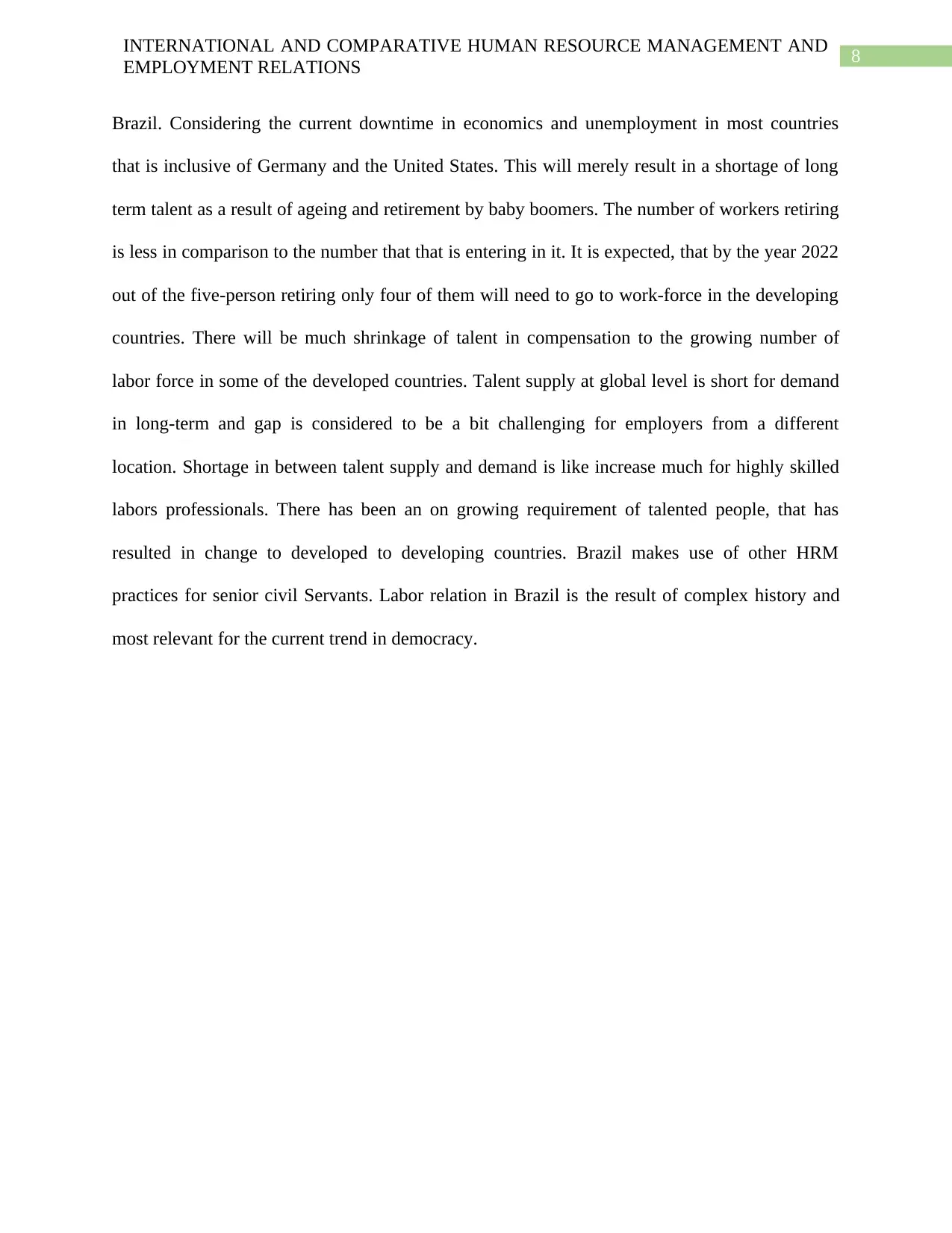
8
INTERNATIONAL AND COMPARATIVE HUMAN RESOURCE MANAGEMENT AND
EMPLOYMENT RELATIONS
Brazil. Considering the current downtime in economics and unemployment in most countries
that is inclusive of Germany and the United States. This will merely result in a shortage of long
term talent as a result of ageing and retirement by baby boomers. The number of workers retiring
is less in comparison to the number that that is entering in it. It is expected, that by the year 2022
out of the five-person retiring only four of them will need to go to work-force in the developing
countries. There will be much shrinkage of talent in compensation to the growing number of
labor force in some of the developed countries. Talent supply at global level is short for demand
in long-term and gap is considered to be a bit challenging for employers from a different
location. Shortage in between talent supply and demand is like increase much for highly skilled
labors professionals. There has been an on growing requirement of talented people, that has
resulted in change to developed to developing countries. Brazil makes use of other HRM
practices for senior civil Servants. Labor relation in Brazil is the result of complex history and
most relevant for the current trend in democracy.
INTERNATIONAL AND COMPARATIVE HUMAN RESOURCE MANAGEMENT AND
EMPLOYMENT RELATIONS
Brazil. Considering the current downtime in economics and unemployment in most countries
that is inclusive of Germany and the United States. This will merely result in a shortage of long
term talent as a result of ageing and retirement by baby boomers. The number of workers retiring
is less in comparison to the number that that is entering in it. It is expected, that by the year 2022
out of the five-person retiring only four of them will need to go to work-force in the developing
countries. There will be much shrinkage of talent in compensation to the growing number of
labor force in some of the developed countries. Talent supply at global level is short for demand
in long-term and gap is considered to be a bit challenging for employers from a different
location. Shortage in between talent supply and demand is like increase much for highly skilled
labors professionals. There has been an on growing requirement of talented people, that has
resulted in change to developed to developing countries. Brazil makes use of other HRM
practices for senior civil Servants. Labor relation in Brazil is the result of complex history and
most relevant for the current trend in democracy.
⊘ This is a preview!⊘
Do you want full access?
Subscribe today to unlock all pages.

Trusted by 1+ million students worldwide
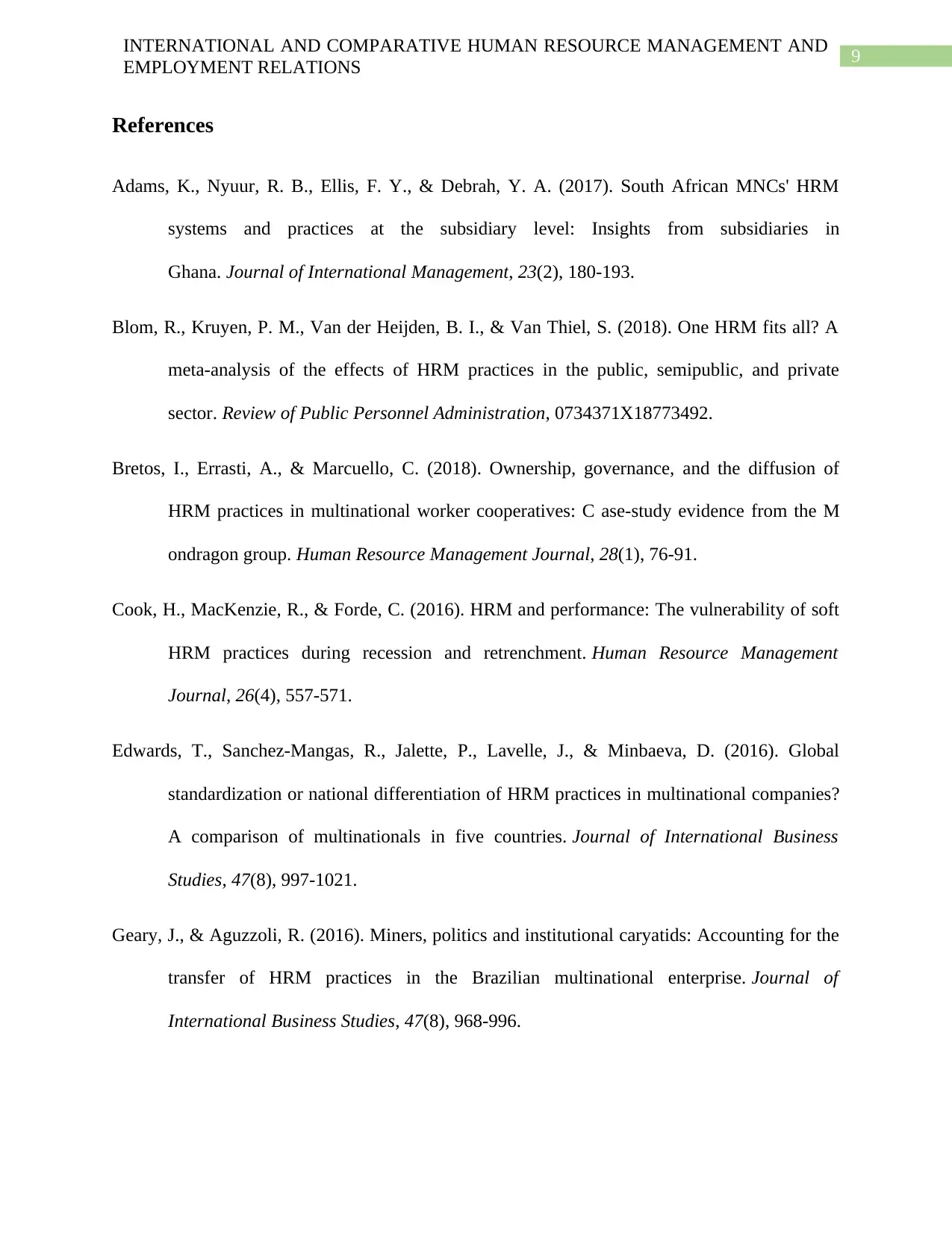
9
INTERNATIONAL AND COMPARATIVE HUMAN RESOURCE MANAGEMENT AND
EMPLOYMENT RELATIONS
References
Adams, K., Nyuur, R. B., Ellis, F. Y., & Debrah, Y. A. (2017). South African MNCs' HRM
systems and practices at the subsidiary level: Insights from subsidiaries in
Ghana. Journal of International Management, 23(2), 180-193.
Blom, R., Kruyen, P. M., Van der Heijden, B. I., & Van Thiel, S. (2018). One HRM fits all? A
meta-analysis of the effects of HRM practices in the public, semipublic, and private
sector. Review of Public Personnel Administration, 0734371X18773492.
Bretos, I., Errasti, A., & Marcuello, C. (2018). Ownership, governance, and the diffusion of
HRM practices in multinational worker cooperatives: C ase‐study evidence from the M
ondragon group. Human Resource Management Journal, 28(1), 76-91.
Cook, H., MacKenzie, R., & Forde, C. (2016). HRM and performance: The vulnerability of soft
HRM practices during recession and retrenchment. Human Resource Management
Journal, 26(4), 557-571.
Edwards, T., Sanchez-Mangas, R., Jalette, P., Lavelle, J., & Minbaeva, D. (2016). Global
standardization or national differentiation of HRM practices in multinational companies?
A comparison of multinationals in five countries. Journal of International Business
Studies, 47(8), 997-1021.
Geary, J., & Aguzzoli, R. (2016). Miners, politics and institutional caryatids: Accounting for the
transfer of HRM practices in the Brazilian multinational enterprise. Journal of
International Business Studies, 47(8), 968-996.
INTERNATIONAL AND COMPARATIVE HUMAN RESOURCE MANAGEMENT AND
EMPLOYMENT RELATIONS
References
Adams, K., Nyuur, R. B., Ellis, F. Y., & Debrah, Y. A. (2017). South African MNCs' HRM
systems and practices at the subsidiary level: Insights from subsidiaries in
Ghana. Journal of International Management, 23(2), 180-193.
Blom, R., Kruyen, P. M., Van der Heijden, B. I., & Van Thiel, S. (2018). One HRM fits all? A
meta-analysis of the effects of HRM practices in the public, semipublic, and private
sector. Review of Public Personnel Administration, 0734371X18773492.
Bretos, I., Errasti, A., & Marcuello, C. (2018). Ownership, governance, and the diffusion of
HRM practices in multinational worker cooperatives: C ase‐study evidence from the M
ondragon group. Human Resource Management Journal, 28(1), 76-91.
Cook, H., MacKenzie, R., & Forde, C. (2016). HRM and performance: The vulnerability of soft
HRM practices during recession and retrenchment. Human Resource Management
Journal, 26(4), 557-571.
Edwards, T., Sanchez-Mangas, R., Jalette, P., Lavelle, J., & Minbaeva, D. (2016). Global
standardization or national differentiation of HRM practices in multinational companies?
A comparison of multinationals in five countries. Journal of International Business
Studies, 47(8), 997-1021.
Geary, J., & Aguzzoli, R. (2016). Miners, politics and institutional caryatids: Accounting for the
transfer of HRM practices in the Brazilian multinational enterprise. Journal of
International Business Studies, 47(8), 968-996.
Paraphrase This Document
Need a fresh take? Get an instant paraphrase of this document with our AI Paraphraser
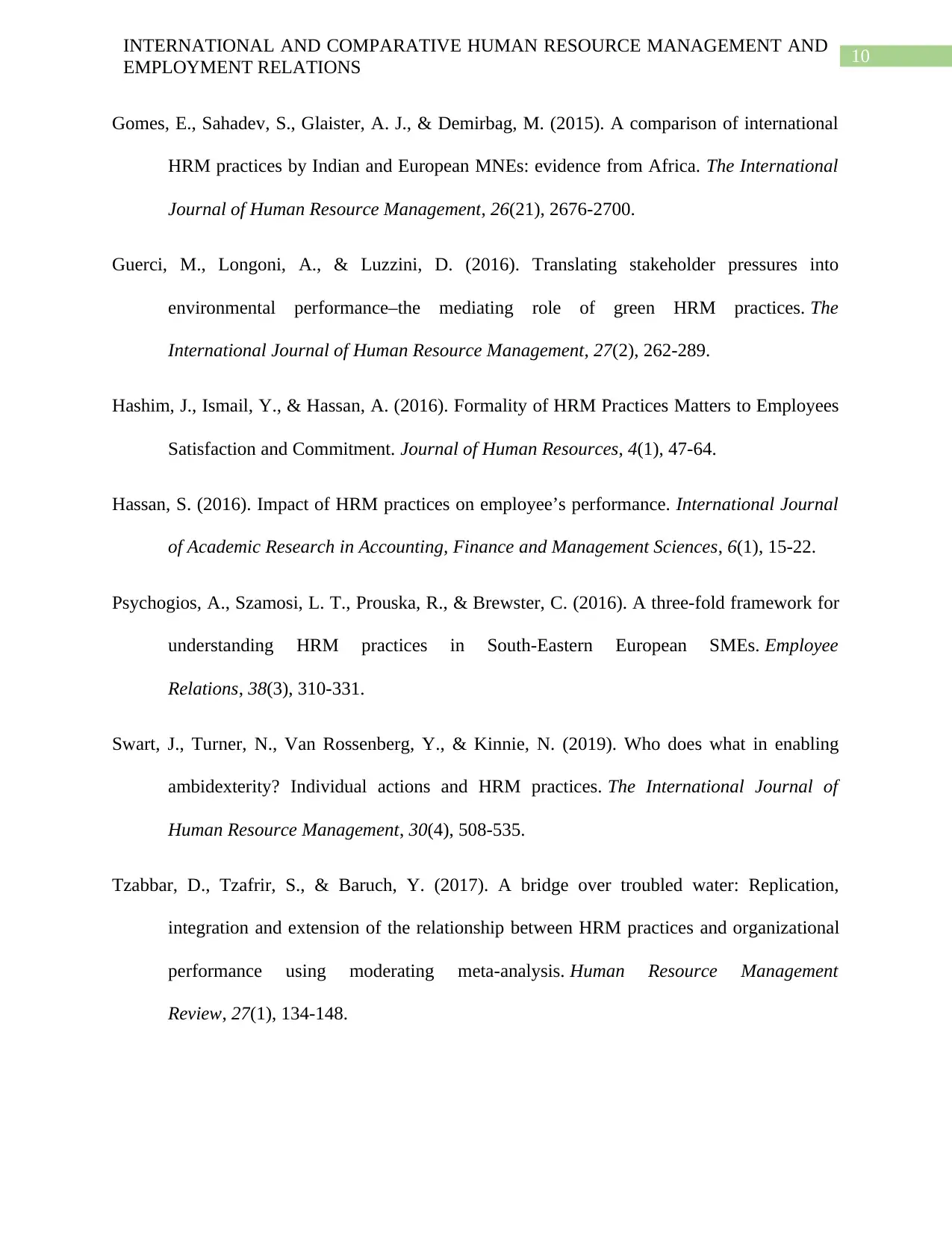
10
INTERNATIONAL AND COMPARATIVE HUMAN RESOURCE MANAGEMENT AND
EMPLOYMENT RELATIONS
Gomes, E., Sahadev, S., Glaister, A. J., & Demirbag, M. (2015). A comparison of international
HRM practices by Indian and European MNEs: evidence from Africa. The International
Journal of Human Resource Management, 26(21), 2676-2700.
Guerci, M., Longoni, A., & Luzzini, D. (2016). Translating stakeholder pressures into
environmental performance–the mediating role of green HRM practices. The
International Journal of Human Resource Management, 27(2), 262-289.
Hashim, J., Ismail, Y., & Hassan, A. (2016). Formality of HRM Practices Matters to Employees
Satisfaction and Commitment. Journal of Human Resources, 4(1), 47-64.
Hassan, S. (2016). Impact of HRM practices on employee’s performance. International Journal
of Academic Research in Accounting, Finance and Management Sciences, 6(1), 15-22.
Psychogios, A., Szamosi, L. T., Prouska, R., & Brewster, C. (2016). A three-fold framework for
understanding HRM practices in South-Eastern European SMEs. Employee
Relations, 38(3), 310-331.
Swart, J., Turner, N., Van Rossenberg, Y., & Kinnie, N. (2019). Who does what in enabling
ambidexterity? Individual actions and HRM practices. The International Journal of
Human Resource Management, 30(4), 508-535.
Tzabbar, D., Tzafrir, S., & Baruch, Y. (2017). A bridge over troubled water: Replication,
integration and extension of the relationship between HRM practices and organizational
performance using moderating meta-analysis. Human Resource Management
Review, 27(1), 134-148.
INTERNATIONAL AND COMPARATIVE HUMAN RESOURCE MANAGEMENT AND
EMPLOYMENT RELATIONS
Gomes, E., Sahadev, S., Glaister, A. J., & Demirbag, M. (2015). A comparison of international
HRM practices by Indian and European MNEs: evidence from Africa. The International
Journal of Human Resource Management, 26(21), 2676-2700.
Guerci, M., Longoni, A., & Luzzini, D. (2016). Translating stakeholder pressures into
environmental performance–the mediating role of green HRM practices. The
International Journal of Human Resource Management, 27(2), 262-289.
Hashim, J., Ismail, Y., & Hassan, A. (2016). Formality of HRM Practices Matters to Employees
Satisfaction and Commitment. Journal of Human Resources, 4(1), 47-64.
Hassan, S. (2016). Impact of HRM practices on employee’s performance. International Journal
of Academic Research in Accounting, Finance and Management Sciences, 6(1), 15-22.
Psychogios, A., Szamosi, L. T., Prouska, R., & Brewster, C. (2016). A three-fold framework for
understanding HRM practices in South-Eastern European SMEs. Employee
Relations, 38(3), 310-331.
Swart, J., Turner, N., Van Rossenberg, Y., & Kinnie, N. (2019). Who does what in enabling
ambidexterity? Individual actions and HRM practices. The International Journal of
Human Resource Management, 30(4), 508-535.
Tzabbar, D., Tzafrir, S., & Baruch, Y. (2017). A bridge over troubled water: Replication,
integration and extension of the relationship between HRM practices and organizational
performance using moderating meta-analysis. Human Resource Management
Review, 27(1), 134-148.
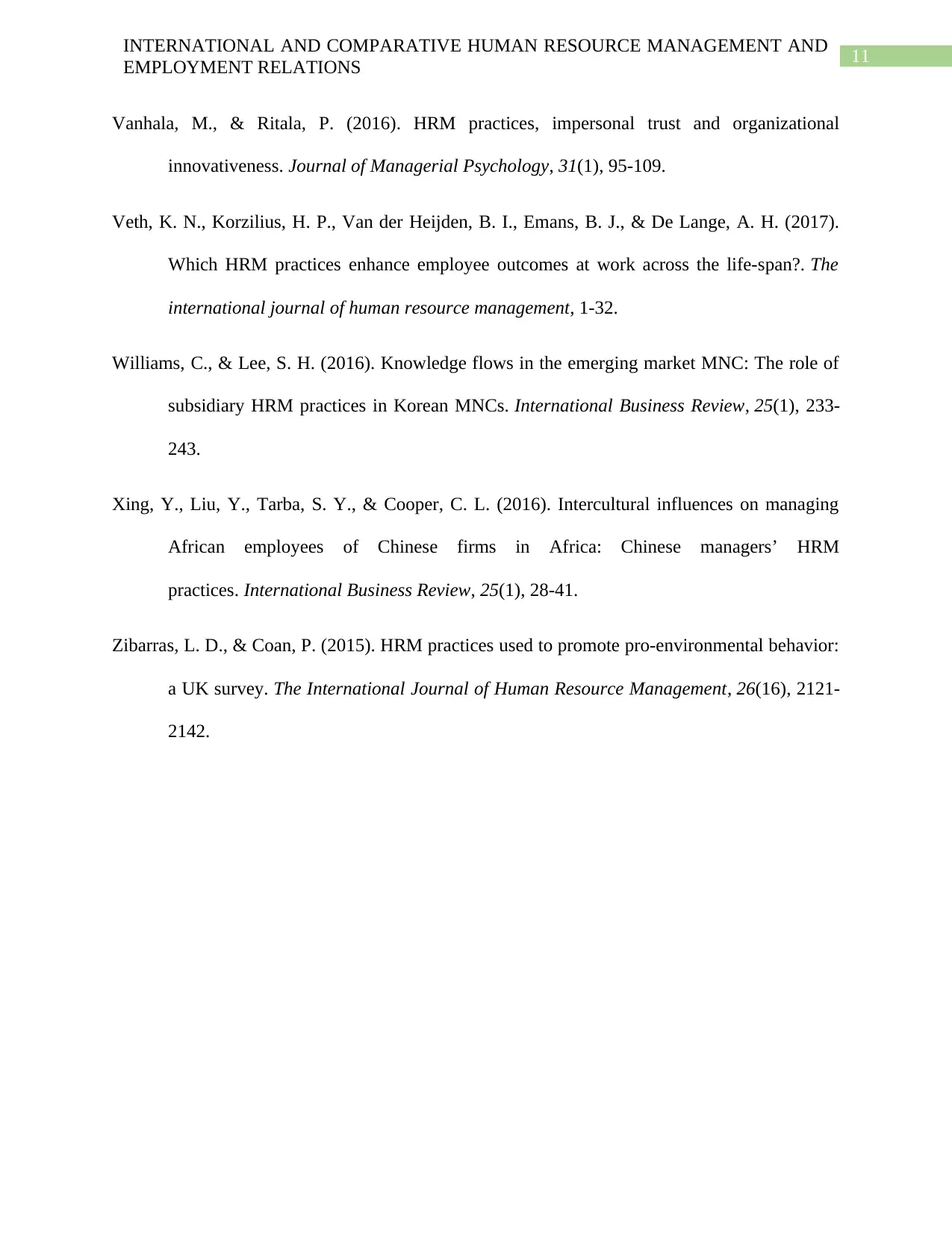
11
INTERNATIONAL AND COMPARATIVE HUMAN RESOURCE MANAGEMENT AND
EMPLOYMENT RELATIONS
Vanhala, M., & Ritala, P. (2016). HRM practices, impersonal trust and organizational
innovativeness. Journal of Managerial Psychology, 31(1), 95-109.
Veth, K. N., Korzilius, H. P., Van der Heijden, B. I., Emans, B. J., & De Lange, A. H. (2017).
Which HRM practices enhance employee outcomes at work across the life-span?. The
international journal of human resource management, 1-32.
Williams, C., & Lee, S. H. (2016). Knowledge flows in the emerging market MNC: The role of
subsidiary HRM practices in Korean MNCs. International Business Review, 25(1), 233-
243.
Xing, Y., Liu, Y., Tarba, S. Y., & Cooper, C. L. (2016). Intercultural influences on managing
African employees of Chinese firms in Africa: Chinese managers’ HRM
practices. International Business Review, 25(1), 28-41.
Zibarras, L. D., & Coan, P. (2015). HRM practices used to promote pro-environmental behavior:
a UK survey. The International Journal of Human Resource Management, 26(16), 2121-
2142.
INTERNATIONAL AND COMPARATIVE HUMAN RESOURCE MANAGEMENT AND
EMPLOYMENT RELATIONS
Vanhala, M., & Ritala, P. (2016). HRM practices, impersonal trust and organizational
innovativeness. Journal of Managerial Psychology, 31(1), 95-109.
Veth, K. N., Korzilius, H. P., Van der Heijden, B. I., Emans, B. J., & De Lange, A. H. (2017).
Which HRM practices enhance employee outcomes at work across the life-span?. The
international journal of human resource management, 1-32.
Williams, C., & Lee, S. H. (2016). Knowledge flows in the emerging market MNC: The role of
subsidiary HRM practices in Korean MNCs. International Business Review, 25(1), 233-
243.
Xing, Y., Liu, Y., Tarba, S. Y., & Cooper, C. L. (2016). Intercultural influences on managing
African employees of Chinese firms in Africa: Chinese managers’ HRM
practices. International Business Review, 25(1), 28-41.
Zibarras, L. D., & Coan, P. (2015). HRM practices used to promote pro-environmental behavior:
a UK survey. The International Journal of Human Resource Management, 26(16), 2121-
2142.
⊘ This is a preview!⊘
Do you want full access?
Subscribe today to unlock all pages.

Trusted by 1+ million students worldwide
1 out of 12
Related Documents
Your All-in-One AI-Powered Toolkit for Academic Success.
+13062052269
info@desklib.com
Available 24*7 on WhatsApp / Email
![[object Object]](/_next/static/media/star-bottom.7253800d.svg)
Unlock your academic potential
Copyright © 2020–2025 A2Z Services. All Rights Reserved. Developed and managed by ZUCOL.





